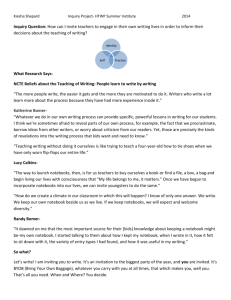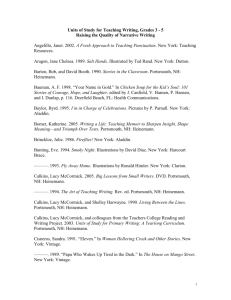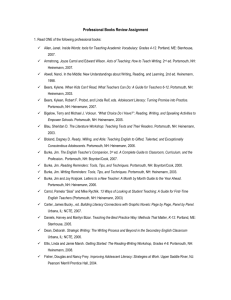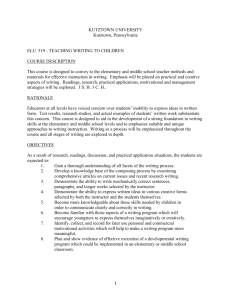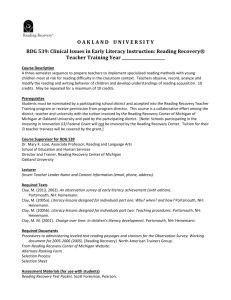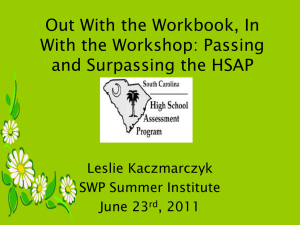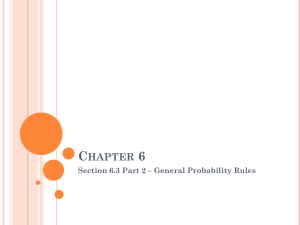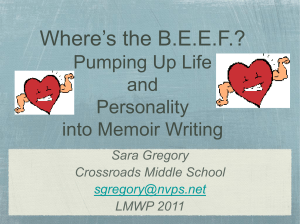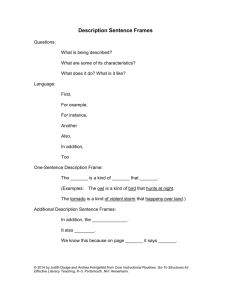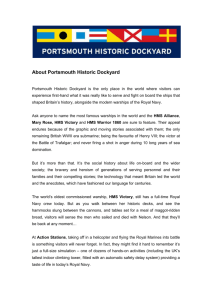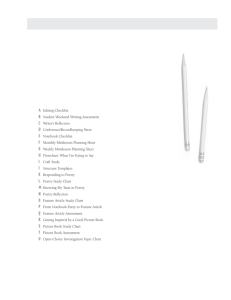Early Number Sense The - Trinity Episcopal School
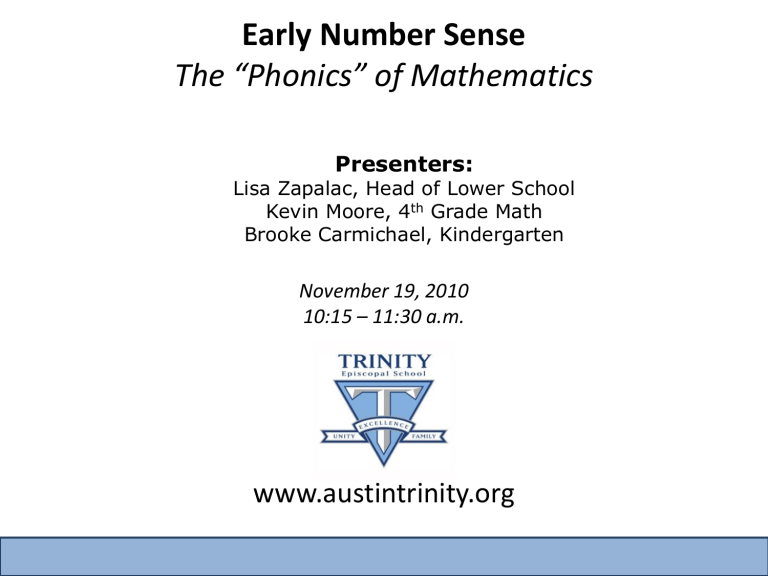
Early Number Sense
The “Phonics” of Mathematics
Presenters:
Lisa Zapalac, Head of Lower School
Kevin Moore, 4 th Grade Math
Brooke Carmichael, Kindergarten
November 19, 2010
10:15 – 11:30 a.m.
www.austintrinity.org
Simplify the following expression:
3,996 + 4,246
Is this how you simplified it?
1 1 1 1
3,996
+4,246
8,242
2 nd Grader Simplifying 3,996 + 4,246
Example of 2nd Grader Using Compensation
How did the 2 nd grader simplify the expression?
He used an addition strategy called compensation, but there are many underlying concepts that are embedded in compensation
1) He noticed that 3,996 is 4 less than 4,000
2) He recognized 4,246 as being equivalent to 4,242+ 4
3) He then associated (3,996 + 4) + 2,242
Evidence of Number Sense
Recognizes unreasonable conclusions
Possesses a repertoire of mental computation strategies
Number
Sense
Recognizes values in their various forms
Demonstrates proficiency with estimation and evaluation of quantities
Let’s try another expression
50 x 48
4th Grade Video
Is this how you simplified it?
4
48
4 x 50
00
+2400
48 x50
2400
240 0
4 th Graders Simplifying
48 (50)
Example 1
Example 2
Example 3
One more…
Solve 76 x 89
4th Grader
Number Sense…. How do we build it?
There are many effective strategies for building number sense. At Trinity, “strings” are one power practice used.
Using “Strings” to Develop Number Sense
Strings are a set of arithmetic problems in which the children are developing very specific strategies. Strings are generally done mentally. Each string begins with a known expression and moves towards the unknown, scaffolding the development of key strategies.
The following slides contain examples of strings at various grade levels.
1
st
Grade String
5 + 5
5 + 6
6 + 6
6 + 7
7 + 7
7 + 8
8 + 8
9 + 7
6 + 8
Building Number Sense through Facts
Possesses a repertoire of mental computation strategies
• Doubles plus or minus 1
– Ex. 6 + 7 = 6 + 6 + 1 (or 7 + 7 – 1) = 13
• Doubles plus or minus 2
– Ex. 5 + 7 = 5 + 5 + 2 (or 7 + 7 - 2)
• Working with the structure of five
– Ex. 6 + 7 = 5 + 1 + 5 + 2 = 10 + 3 = 13
• Making tens
– Ex. 8 + 4 = 8 + 2 + 2
• Using tens to solve nines
– Ex. 9 + 7 = 10 + 7 - 1
• Using compensation
– Ex. 6 + 8 = 7 + 7 (adding one to one addend, while subtracting one from the other addend)
5 + 5
5 + 6
6 + 6
6 + 7
7 + 7
7 + 8
8 + 8
9 + 7
6 + 8
Using Tools and Models to
Develop Number Sense
Recognizes values in their various forms
The rekenrek, or arithmetic rack, is a tool consisting of two rows of ten beads with two sets of five in each. The rekenrek was developed by Adri Treffers, a researcher at the Freudenthal Institute in the Netherlands, and it provides a powerful model for exploring the composing and decomposing of number (Treffers 1991)
Recognizes values in their various forms
Kindergarten String
Example
Kindergarten String
5 on the top, 5 on the bottom
7 on the top, 3 on the bottom
4 on the top, 6 on the bottom
6 on the top, 4 on the bottom
8 on the top, 2 on the bottom
Possesses a repertoire of mental computation strategies
2
Moving Beyond Facts
Modeling 38 + 42
40
38 40
80
The open number line is a tool used to model students’ thinking. In this problem, 38 + 42, a student might solve it by moving to a landmark number first. Or, they might first make jumps of ten.
40 2
38
78 80
Example of 2 nd Grade String
Big Idea: Keeping One Number Whole and Taking Leaps of 10
2nd Grade String
75 + 20
75 + 25
75 + 24
55 + 30
55 + 39
69 + 21
69 + 29
Building Number Sense with Multiplication
Constructing facts through relationships and models
4(4) = 16 2[(4)2] or 2(8)
Multiplication
(3 rd & 4 th Grade Strategies)
• Doubling
▪ 6 x 6 = 2 x 3 x 6
• Halving and doubling
▪ 4 x 3 = 2 x 6
• Using the distributive property
▪ 7 x 8 = (5 x 8) + (2 x 8), or
▪ 7 x 8 = (8 x 8) – (1 x 8)
• Using the commutative property
▪ 5 x 8 = 8 x 5
Possesses a repertoire of mental computation strategies
Example of 4 th Grade String
4th Grade Multiplication String
4 x 8
14 x 8
6 x 9
26 x 9
12 x 13
15 x 24
4 th Grade String Revisited –
Connecting to Algebra a (8)
(a + b) 8
(3a)2
(2a + c) (5)
(a + 3) (a + 2)
Number sense is the bridge between arithmetic and algebra
Number Sense
Arithmetic Algebra
Resources
Books
Ma, L. (1999). Knowing and Teaching Elementary Mathematics. Mahwah, NJ: Lawrence Erlbaum Associates, Inc.
Devlin, K. (2000). The Math Gene. Great Britain: Weidenfeld & Nicolson
Stigler & Hiebert (1999). The Teaching Gap. New York, NY: The Free Press
Fosnot, C., & Dolk, M. (2001). Young Mathematicians at Work: Constructing Number Sense, Addition, and Subtraction. Portsmouth, NH:
Heinemann
Fosnot, C., & Dolk, M. (2001). Young Mathematicians at Work: Constructing Multiplication and Division. Portsmouth, NH: Heinemann
Carpenter, T., Franke, M., & Levi, L. (2003). Thinking Mathematically: Integrating Arithmetic and Algebra in Elementary School. Portsmouth, NH:
Heinemann
Fosnot, C. & Uittenbogaard, W. (2007). Minilessons for Early Addition and Subtraction. Portsmouth, NH: Heinemann
Fosnot, C. & Uittenbogaard, W. (2007). Minilessons for Extending Addition and Subtraction. Portsmouth, NH: Heinemann
Fosnot, C. & Uittenbogaard, W. (2007). Minilessons for Early Multiplication and Division. Portsmouth, NH: Heinemann
Fosnot, C. & Uittenbogaard, W. (2007). Minilessons for Extending Multiplication and Division. Portsmouth, NH: Heinemann
Articles
Faulkner, V. (2009). The Components of Number Sense – An Instructional Model for Teachers. – Teaching Exceptional Children, Vol. 41, No. 5,
24-30
Gersten, R. & Chard, D. (2010). Validating a Number Sense Screening Tool for Use in Kindergarten and First Grade: Prediction of Mathematics
Proficiency in Third Grade – School Psychology Review, Vol. 39, No. 2, 181-195
Harel, G. & Rabin, J. (2010). Teaching Practices Associated With the Authoritative Proof Scheme – Journal for Research in Mathematics
Education, Vol. 41, No. 1, 14-19
Web Sites
DreamBox Learning www.dreambox.com
To order a rekenrek: www.eNasco.com
